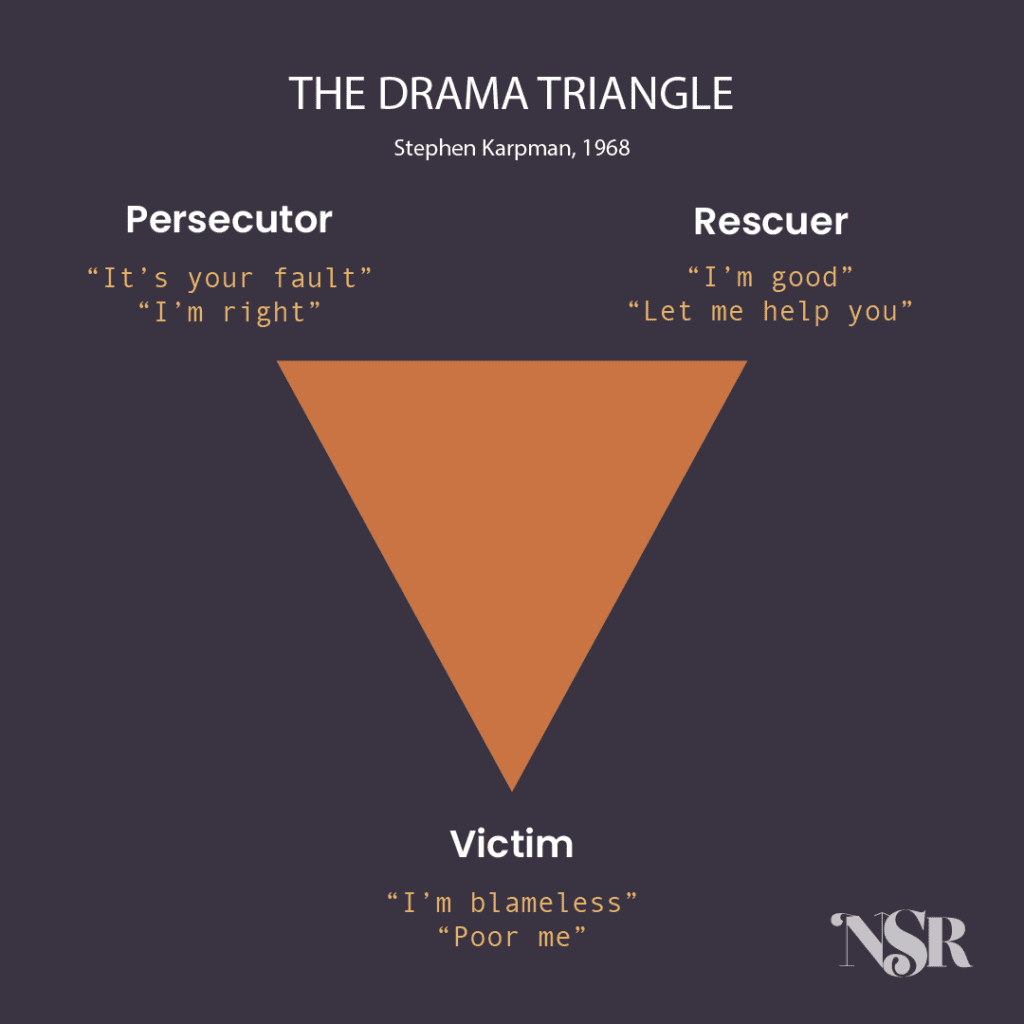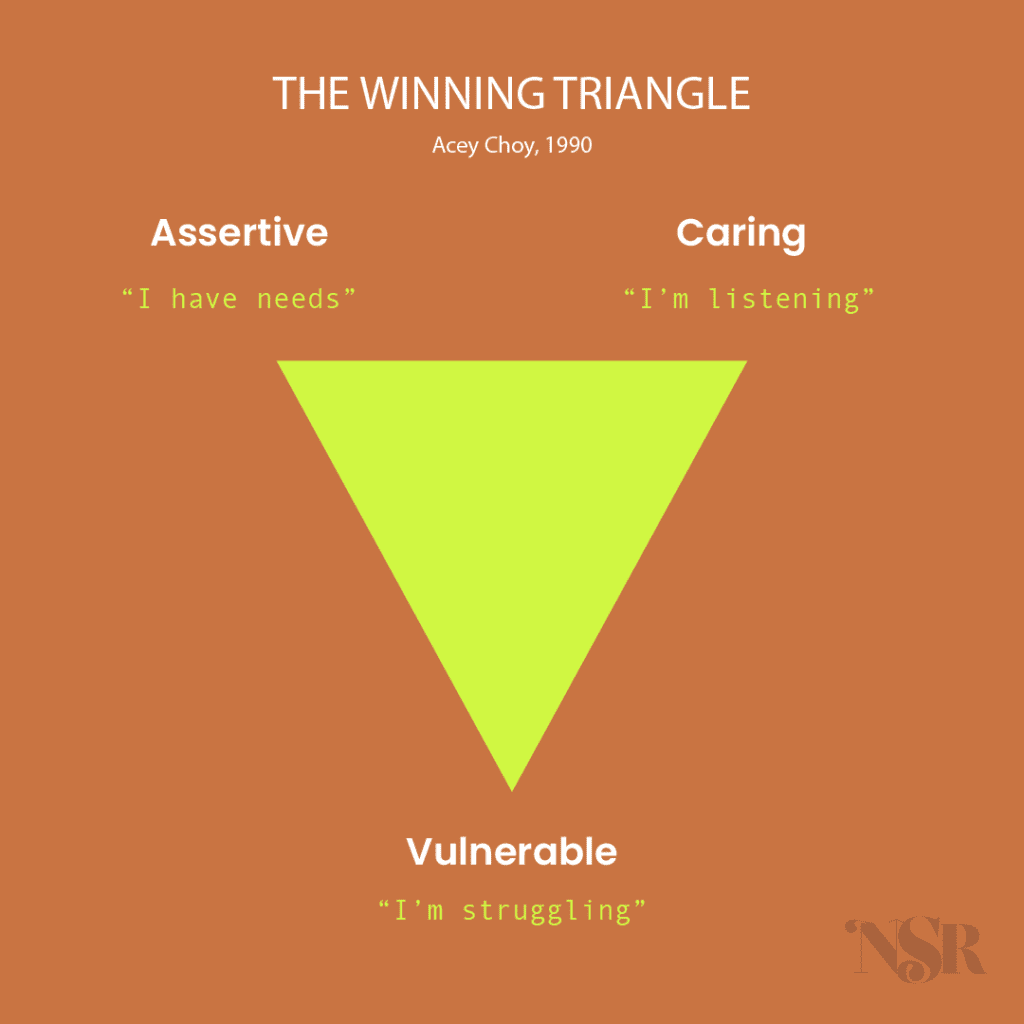The first time I saw the “Drama Triangle,” I winced.
My coach, Miriam, showed it to me during a coaching session, after I described a situation with a coworker in which I was sure I was right and my coworker was most definitely wrong.
I instantly recognized who I was on the triangle: the Persecutor.
I didn’t like that persona nor the idea of “drama.” But I knew both of those labels rang true.
The Drama Triangle

The drama triangle is a model developed by Stephen Karpman in 1968 that identifies how we behave in conflict — in “drama.” We assume one (or all) of these roles:
→ Persecutor: “I’m right” “It’s your fault”
→ Rescuer: “I’m good” “Let me help you”
→ Victim: “I’m blameless” “Poor me”
Are any of these roles familiar to you?
Each of us has a default role that we fall into in conflict. But the roles aren’t static—we can spin through all three roles in the course of one conversation, or even in one sentence.
One of my coaching clients described to me how she experiences these roles: “I get caught in a drama tornado!” She experiences the triangle as a tornado, pulling her through all three roles continuously and chaotically.
Why We Get Stuck On the Triangle
Why do we attach to these roles? Well, we do it in order to be right. And the tighter we grasp onto being right, the stucker we get.
When we’re caught in the triangle, we approach the conflict feeling justified in whatever role(s) we’re playing. We feel right—and righteous.
And this righteousness makes sense when you consider each role:
- When you Rescue, you feel justified in being perceived as good and helpful. Who could argue with being helpful?! But in order to Rescue, you must have someone to save; there must be a victim. You end up enabling them or being a crutch. You strip them of their ability to help themselves—which isn’t helpful after all.
- When you Persecute, you feel justified in holding someone (or something) accountable. This shows up as control, blame, manipulation, mistrust, judgment or bullying. And you need a victim in order to be right.
- When you play Victim, you feel justified that something has happened to you, outside of your control. This could show up as neediness, negativity, fear, or a “poor me” mindset. You end up needing someone to rescue you.
No matter how justified we feel in the moment, we’re actually entrenched—and we don’t get much closer to solving the core problem. It becomes something of a catch-22: we feel right but we don’t feel resolved… which means that in order to resolve the conflict, maybe we aren’t right after all.
The bad news: There will always be conflict when we’re building with and leading people. The good news: we can take responsibility for how we show up to the drama, and make a choice to shift to problem-solving.
How to Get Off of the Drama Triangle

In response to Karpman’s drama triangle, education researcher Acey Choy developed The Winning Triangle in 1990. Her reinterpretation takes conflict from drama to “winning.”
The drama triangle is a black and white, win/lose way to view the world. The Winning Triangle, in contrast, replaces each drama role with a specific skill to better relate to others when in conflict. It’s a win/win approach to problem-solving.
With awareness and practice, it gets easier to shift out of drama. Here are the steps to get off the drama triangle:
Step 1
Become aware when you’re on the triangle, and which role(s) you’re playing. Think of a recent conflict and reflect on which drama role(s) you played, and specifically how you played that role. What did you say? How did you behave toward the other person? How did you feel during or immediately after the conflict? This reflection creates awareness.
Step 2
Take personal responsibility for your actions whenever you’re playing that role. Your actions include words, behaviors, and, perhaps most importantly, your thoughts about the conflict. Reflect on what the drama role is actually producing in the relationship with this person (and it likely isn’t producing “resolution” or “clarity” or “understanding”!). And please be gentle with yourself in this process. Everyone gets caught in the drama triangle.
Step 3
Choose to step out of that role into a new mindset. Here’s how to shift away from each of the drama roles:
The Persecutor Becomes Assertive: “I have needs”
Find a way to recognize how you’ve contributed to the situation. Then, identify your needs and wants. You can become a potent negotiator. From that mindset you can assert your needs — rather than demand, bully or bulldoze others.
The Rescuer Becomes Caring: “I’m listening”
You listen before you jump to fixing or playing the hero. From a place of listening, you’ll be better equipped to understand those around you, and wait for help to be requested before you start taking action. From this mindset, you can empower those around you to find their own way.
The Victim Becomes Vulnerable: “I’m struggling”
Get into action! Reorient yourself from “something has been done to me” to “what small or big step can I take to experience more agency?” From a place of vulnerability, the victim can develop the skill of problem solving.
What’s Possible Outside of the Drama Triangle
Off the drama triangle, you get to lead from power and possibility.
- You make sure your own needs are met even when supporting others
- You take personal responsibility and power in your relationships
- You orient to problem-solving
- You create clear agreements with the people around you
- You see others as whole and capable of taking their own necessary actions
- You see the people around you as equals, and potentially even as allies
- You easily return to creativity, curiosity and groundedness
- You are whole in your leadership
Whoa. I’ve never seen these triangles before. What a clear explanation through conflict. Pocketing this one!
I regard the drama triangle as cringey-good…It’s so accurate and the drama roles make me SO want to get the heck off the triangle. 🙂